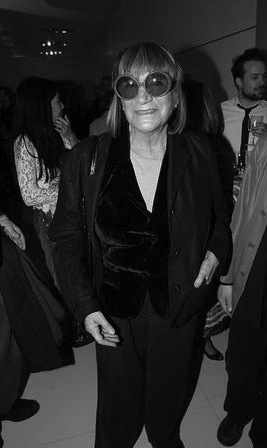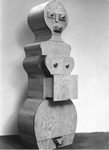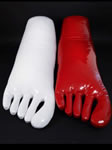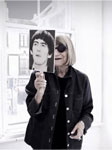After working between Europe and the United States for nearly twelve years, in 1979 Nicola L moved definitively to live and work in New York City.
The Red Coat is on currently on display at Tate Modern as part of the The EY Exhibition: The World Goes Pop, 17 September 2015 – 24 January 2016.
Influenced by the socio-political upheavals and demonstrations of the 1960s, Red Coat, 1969, was designed for a concert of Brazilian musicians Gilberto Gil and Caetano Veloso, which took place at the Isle of Wight Festival in 1970. Created for various improvised performances in public spaces, the Red Coat is exemplary of Nicola L’s experimentation with presenting the human body as a conceptual piece of art.
Nicola L. studied art at the Académie Julian in Paris, followed by the École des Beaux-Arts in Paris at the atelier of painter Jean Souverbie. Coming to New York for the first time in 1967 at the invitation of La MaMa theater, she had become a permanent transplant by the end of the 70s. Her conceptual work hinges on two approaches that open the door to a myriad of possibilities – to make bodies, and to embody. To embody, meaning to collect bodies within a single skin in order to inhabit a space collectively, organically, and see it from the vantage of a second skin. Red Coat Same Skin For Everyone (1969) is a vast frameless canvas, molded around 11 empty pockets tailored to fit the dimensions of 11 human bodies. The coat was conceived as part of a performance to accompany musicians Gilberto Gil and Caetano Veloso at the Isle of Wight music festival. Traveling the world since 2002 with her « art-skins » (Cuba, Paris, Los Angeles, the Great Wall of China, all the way to the European Parliament in Brussels), the artist extends an invitation out to everybody to take part, through performance, in what Michel Onfray calls « the odyssey of flesh ».
For Nicola L.,
making bodies implies destroying them first. In the ultimate metonymical act, she sends out into the world functional objects that are fragments of our own bodies: The Eye-Lamp (1969), The Woman-Dresser (with irony on the theme of objectified women, 1969), The Eye-Table (1970), The Cultivated Head (1980), The Head-Bookcase (1996). At times, both approaches converge: making bodies, which can then be embodied through usage (The Hand-Sofa, 1970-72 ; The Head-Sofa, 1989). Both approaches are married in The Head-Aquarium (2005), where a swimming goldfish becomes, at random, an eye.





